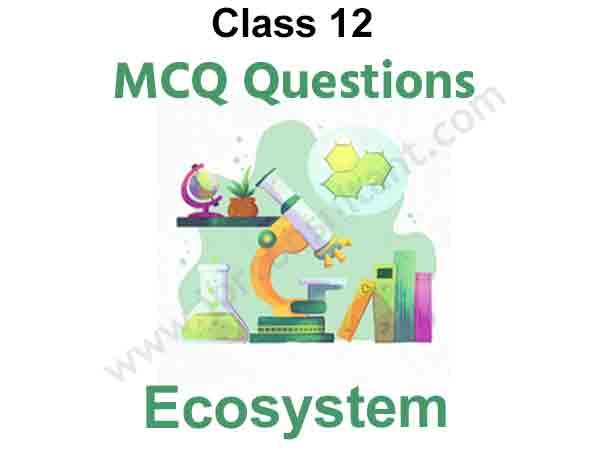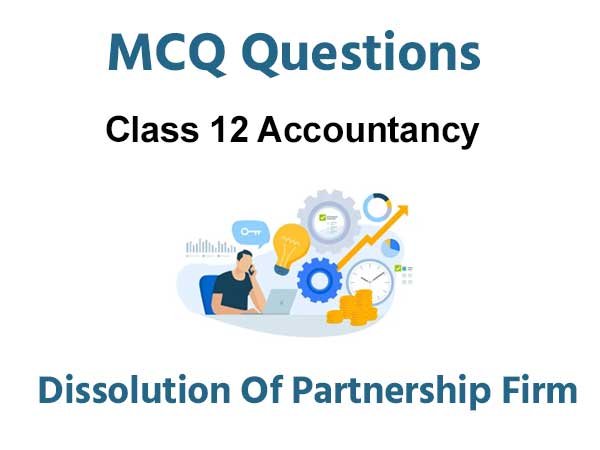Class 12 Ecosystem MCQs is one of the best strategies to prepare for the CBSE Class 12 Board exam. If you want to complete a grasp concept or work on one’s score, there is no method except constant practice. Students can improve their speed and accuracy by doing more MCQ on Ecosystem class 12, which will help them all through their board test.
Class 12 Ecosystem MCQs Questions with Answers
Class 12 Biology MCQs with answers are given here to chapter the Ecosystem These MCQs are based on the latest CBSE board syllabus and relate to the latest Class 12 Biology syllabus. By Solving these Class 12 Ecosystem MCQs, you will be able to analyze all of the concepts quickly in the chapter and get ready for the Class 12 Annual exam.
Learn Ecosystem Class 12 MCQs with answers pdf free download according to the latest CBSE and NCERT syllabus. Students should prepare for the examination by solving CBSE Class 12 Biology Ecosystem MCQs with answers given below.
Question 1. Which one of the following is a characteristic feature of cropland ecosystem?
(a) Absence of weeds
(b) Ecological succession
(c) Absence of soil organisms
(d) Least genetic diversity
Answer
D
Question 2. A scorpion stalks, kills, and then eats a spider. Based on its behavior, which ecological terms describe the scorpion?
(a) producer, herbivore, decomposer
(b) producer, carnivore, heterotroph
(c) predator, carnivore, consumer
(d) predator, autotroph, herbivore
Answer
C
Question 3. Which one of the following is one of the characteristics of a biological community?
(a) Stratification
(b) Natality
(c) Mortality
(d) Sex-ratio
Answer
A
Question 4. The primary producers of the deep-sea hydrothermal vent ecosystem are
(a) green algae
(b) chemosynthetic bacteria
(c) blue-green algae
(d) coral reefs.
Answer
B
Question 5. The function of leghaemoglobin during biological nitrogen fixation in root nodules of legumes is to
(a) convert atmospheric N2 to NH3
(b) convert ammonia to nitrite
(c) transport oxygen for activity of nitrogenase
(d) protect nitrogenase from oxygen
Answer
D
Question 6. The breakdown of detritus into smaller particles by earthworm is a process called
(a) humification
(b) fragmentation
(c) mineralisation
(d) catabolism.
Answer
B
Question 7. When man eats fish which feeds on zooplanktons which have eaten small plants, the producer in this chain is
(a) small plants
(b) fish
(c) man
(d) zooplankton.
Answer
A
Question 8. The rate at which light energy is converted into chemical energy of organic molecules is the ecosystem’s
(a) net secondary productivity
(b) gross primary productivity
(c) net primary productivity
(d) gross secondary productivity.
Answer
B
Question 9. The mass of living material at a trophic level at a particular time is called
(a) net primary productivity
(b) standing crop
(c) gross primary productivity
(d) standing state.
Answer
B
Question 10. Primary productivity
(a) is equal to the standing crop of an ecosystem.
(b) is greatest in freshwater ecosystems.
(c) is the rate of conversion of light to chemical energy in an ecosystem.
(d) is inverted in some aquatic ecosystems
Answer
C
Question 11. Upper part of sea/aquatic ecosystem contains
(a) plankton
(b) nekton
(c) plankton and nekton
(d) benthos.
Answer
A
Question 12. Natural reservoir of phosphorus is
(a) rock
(b) fossils
(c) sea water
(d) animal bones.
Answer
A
Question 13. Most of the desert plants bloom during night time because
(a) their blooming is controlled by low temperature.
(b) they are sensitive to the phases of moon.
(c) the desert insects eat away flowers during day time.
(d) the desert insects are active during night time.
Answer
D
Question 14. Secondary productivity is rate of formation of new organic matter by
(a) consumers
(b) decomposers
(c) producers
(d) parasites
Answer
A
Question 15. Trophic levels are formed by :
(a) plants
(b) animals
(c) organisms linked in food chain
(d) carnivores
Answer
C
Question 16. A very efficient converter of solar energy with net productivity of 204 kg/m2 or more is the crop
(a) wheat
(b) sugarcane
(c) rice
(d) bajra.
Answer
B
Question 17. The biomass available for consumption by the herbivores and the decomposers is called
(a) net primary productivity
(b) secondary productivity
(c) standing crop
(d) gross primary productivity.
Answer
A
Question 18: Which of the following is not a producer?
a) Agaricus
b) Nostoc
c) Volvox
d) Spirogyra
Answer
A
Question 19. Which of the following ecological pyramids is generally inverted?
(a) Pyramid of biomass in a sea
(b) Pyramid of numbers in grassland
(c) Pyramid of energy
(d) Pyramid of biomass in a forest
Answer
A
Question 20. About 70% of total global carbon is found in
(a) oceans
(b) forests
(c) grasslands
(d) agroecosystems.
Answer
A
Whoever needs to take the CBSE Class 12 Board Exam should look at this MCQ. To the Students who will show up in CBSE Class 12 Biology Board Exams, It is suggested to practice more and more questions. Aside from the sample paper you more likely had solved. These Class 12 Ecosystem MCQs are ready by the subject specialists themselves.
Question 21. Best soil for plant growth is:
(a) Grit
(b) Sandy
(c) Soily
(d) Clay
Answer
D
Question 22. Which one of the following types of organisms occupy more than one trophic level in a pond ecosystem?
(a) Fish
(b) Zooplankton
(c) Frog
(d) Phytoplankton
Answer
A
Question 23. Energy transfer from one trophic level to other, in a food chain, is
(a) 10%
(b) 20%
(c) 1%
(d) 2%.
Answer
A
Question 24. How much of the net primary productivity of a terrestrial ecosystem is eaten and digested by herbivores?
a) 10%
b) 1%
c) 40%
d) 90%
Answer
A
Question 25. In a biotic community, the primary consumers are
(a) detritivores
(b) herbivores
(c) carnivores
(d) omnivores.
Answer
B
Question 26. During ecological succession
(a) the numbers and types of animals remain constant
(b) the changes lead to a community that is in near equilibrium with the environment and is called pioneer community
(c) the gradual and predictable change in species composition occurs in a given area
(d) the establishment of a new biotic community is very fast in its primary phase.
Answer
C
Question 27 .Hibernation of some animals:
(a) Regular
(b) Periodic
(c) Suddenly
(d) Temporary
Answer
A
Question 28. Water co-deficient contains:
(a) Large thin walled cells
(b) Large-vacuoles
(c) Membrane
(d) All of these
Answer
C
Question 29. The upright pyramid of number is absent in
(a) pond
(b) forest
(c) lake
(d) grassland.
Answer
B
Question 30. The mass of living materials at a trophic level at a particular time is called ____
A. Standing state
B. Standing crop
C. Gross primary productivity
D. Net primary productivity
Answer
B
Question 31. Flora and fauna in lake or ponds is
(a) lentic biota
(b) lotic biota
(c) abiotic biota
(d) field layer
Answer
A
Question 32. Which one of the following is not a function of an ecosystem?
(a) Energy flow
(b) Decomposition
(c) Productivity
(d) Stratification
Answer
D
Question 33. Which of the following pairs is a sedimentary type of biogeochemical cycle?
(a) Phosphorus and nitrogen
(b) Phosphorus and sulphur
(c) Oxygen and nitrogen
(d) Phosphorus and carbon dioxide
Answer
B
Question 34. Pyramid of numbers deals with number of
(a) species in an area
(b) individuals in a community
(c) individuals in a trophic level
(d) subspecies in a community.
Answer
C
Question 35. The primary succession refers to the development of communities on a
(a) forest clearing after devastating fire
(b) newly-exposed habitat with no record of earlier vegetation
(c) freshly cleared crop field
(d) pond, freshly filled with water after a dry phase.
Answer
B
Question 36. Both hydrarch and xerarch successions lead to
(a) medium water conditions
(b) xeric conditions
(c) highly dry conditions
(d) excessive wet conditions.
Answer
A
Question 37. During food chain the maximum energy is stored in :
(a) Producers
(b) Decomposers
(c) Herbivoures
(d) Camivourse
Answer
A
Question 38. The food chain in which microbes breakdown energy rich compounds synthesized by producers is called
(a) ecosystem
(b) parasitic food chain
(c) detritus level chain
(d) predator food chain
Answer
C
Question 39. Best type of pyramid which is always true is:
(a) Pyramid or energy
(b) Pyramid of Biomass
(c) Pyramid of number
(d) Both (a) and (c)
Answer
A
Question 40. Which one of the following is not a gaseous biogeochemical cycle in the ecosystem
A. Carbon cycle
B. Oxygen cycle
C. Phosphorus cycle
D. Nitrogen cycle
Answer
C
Question 41. Arrange the following ecosystems in increasing order of mean NPP (Tonnes / ha / year)
A. Tropical deciduous forest
B. Temperate coniferous forest
C. Tropical rain forest
D. Temperate deciduous forest
(a) B < A < D < C
(b) D < B < A < C
(c) A < C < D < B
(d) B < D < A < C
Answer
D

You can easily get good marks If you study with the help of Ecosystem Class 12 MCQ. We trust that information provided is useful for you. NCERT MCQ Questions for Class 12 Ecosystem PDF Free Download would without a doubt create positive results.
We hope the information shared above in regards to MCQ on Ecosystem Class 12 with Answers has been helpful to you. if you have any questions regarding CBSE Class 12 Ecosystem MCQs Pdf, write a comment below and we will get back to you as soon as possible.
Frequently Asked Question (FAQs)
How many MCQ questions are there in CLass 12 chapter 14 Biology?
In Class 12 chapter 14 Biology, we have provided 41 Important MCQ Questions, But in the future, we will add more MCQs so that you can get good marks in the Class 12 exam.
Can we score good marks in Class 12 Biology with the help of Ecosystem MCQ Questions?
Yes, MCQ Question is one of the best strategies to make your preparation better for the CBSE Board Exam. It also helps to know the student’s basic understanding of each chapter. So, You can easily score good marks in the Class 12 BIology exam.

